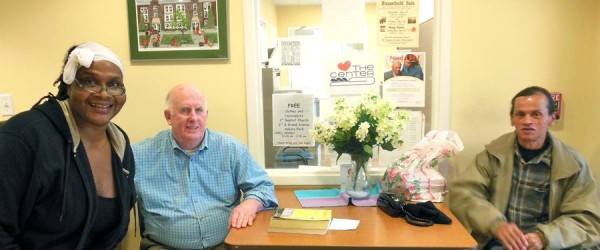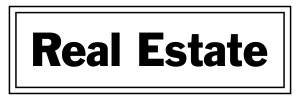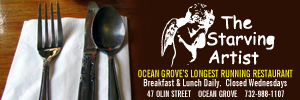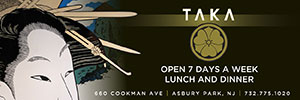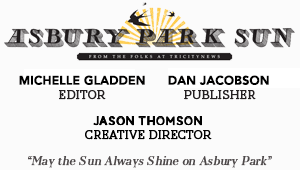At The Center, AIDS still part of the conversation
Will hold 20th anniversary fundraiser June 8
In the 1980s and 1990s, AIDS was an epidemic that was a major part of the global conversation. Now, talk of the disease has died down and many think it is only an issue in third-world countries.
In reality, people are still contracting the disease worldwide — and in Monmouth County. The Center in Asbury Park supports 300 local victims of the disease with food, shelter and other outreach programs, even though many of their neighbors may not see AIDS as a problem anymore.
The Center’s founder, Rev. Robert Keading, or Father Bob [pictured above, center, with two clients], recalls a time in the late 1990s when he encountered a young man while working in downtown Asbury Park and they got to talking about AIDS.
“He said, ‘Luckily, the disease is gone,'” he said. “I said, ‘Why do you say that?’ He said, ‘I read in the paper they had a cure.'”
It’s true AIDS is no longer a death sentence, but it is still a chronic illness that requires daily medical attention. In Monmouth County, more than 2,400 people have AIDS or HIV, according to data provided by the state’s Department of Health and Senior Services. In 2010, 45 new cases of HIV or AIDS were reported in Monmouth County — down from a peak of 293 new cases in 1992. The Center was founded that same year.
The Center in Asbury Park first opened in a Mattison Avenue storefront. This year marks the organization’s 20th birthday. Since 2006, it has been headquartered on Third Avenue in a building with 25 residential units, all occupied by people who have AIDS and were previously homeless.
Most of those infected today are young people who are not taking the proper precautions, Father Bob said. In his experience, most of the newly-infected are former intravenous drug users and young gay people, although The Center never asks its clients how they contracted AIDS because “it doesn’t make a difference,” he said.
AIDS is most commonly spread through sexual contact and hypodermic needles. In the 1980s, medicine had not yet been developed to mitigate the disease’s most visible symptoms, such as wasting away of the body and skin spots caused by Kaposi sarcoma. Today, the disease is less visible in people because of that medication.
In 1988 if someone were diagnosed, they were probably dead within the year, Father Bob said. Today, people live relatively long lives with the disease — but their medications can be costly and it can be difficult to hold a job while AIDS-positive. This means people who have the disease often face grave financial hardships. People with AIDS can also have a hard time finding housing, which Father Bob says is crucial.
“Years ago there was a saying, ‘Housing is healthcare,'” Father Bob said. “If people don’t have a decent place to live, how can they take care of their health? Many people [who have AIDS] are living on social security income. But if it’s $700 a month, which is typical, where do you live?”
Many people who live at The Center previously lived on the streets or in their cars, Father Bob said. Sometimes, they are people whose housing situations have changed due to the death of an elderly parent.
Those who live in The Center receive “supportive housing,” meaning they receive three meals a day. The Center also used to have laundry facilities for its clients until funding dried up.
The Center doesn’t only help the 25 people who live there, but also about 300 other clients who live in Monmouth and Ocean counties. People with AIDS who don’t live at The Center can also take home frozen meals and at times, The Center is able to provide them with bus passes and other types of transportation. Clients are referred to The Center by healthcare organizations like Jersey Shore University Medical Center and the Monmouth County Board of Health.
In addition to providing people with AIDS with basic necessities for living, The Center also helps them partake in art projects and occasional trips to the theater or theme parks.
Many of The Center’s volunteers come from the city’s religious communities, Father Bob said, although the organization is not technically affiliated with any religion or faith. Most people contract AIDS in ways that are not sanctioned by major religions, such as drug use and extramarital sex, but Father Bob said this does not help people from the religious community from helping those in need.
In The Center’s early days, Father Bob addressed a group of women at a Methodist church.
“They were asking me questions about homelessness and poverty,” he said. “Finally, the pastor said, ‘We’re here to talk about The Center and AIDS. There are two things you don’t want to talk about in church: sex and drugs. And that’s what we’re going to talk about today.’”
About 75 volunteers help at The Center each week, 85 percent of whom are from religious groups, Father Bob said.
“These people are here because they know we should be talking about it,” he said. “We’ve provided a place for people who are very spiritual and they come here because they want to serve the poor. They don’t care if they’re gay or straight or drug users. It’s just a matter of serving people. I don’t think a church can be authentic and ignore it.”
Much of The Center’s funding comes from grants that are written for specific causes, such as shelter or food. For this reason, fundraising is important. The organization orchestrated the Asbury Park contingent of the NJ AIDS Walk on May 6 to raise money for its programs.
Also, on June 8 at Convention Hall, they will hold Center A La Carte, a tasting dinner for 500 people. The dinner will feature more than 30 restaurants and beverage vendors for 500 guests. The event also features a silent auction, a chance auction and a 50/50 raffle. For more information, go to http://www.thecenterinap.com/pages/

